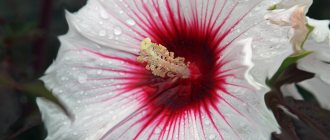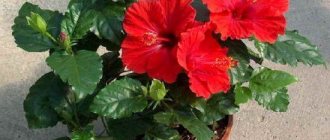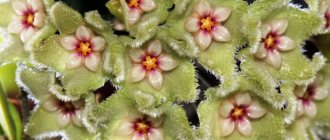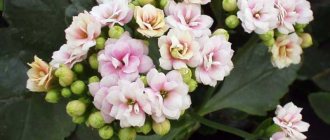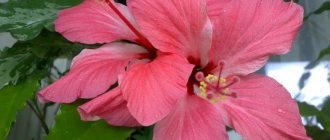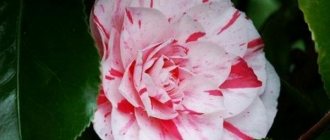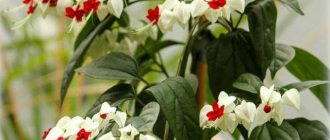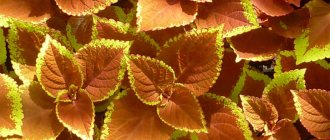How to plant at home?
Hibiscus is an unpretentious plant, but its transplantation has several subtleties.
Soil/soil - what soil is suitable for a tea rose?
Chinese rose cuttings are transplanted into loose soil with neutral acidity - it promotes their rapid root formation. Young plants need nutritious, but not greasy soil.
Adult hibiscus are less demanding on the soil; only 2 conditions must be met - drainage and good looseness . An adult plant is replanted only when the pot becomes too small for it.
Soil composition
To plant cuttings, use clean sand or a mixture of one part sand and one part peat. It stays in such soil for 25-30 days - during this period the plant develops a stable root system and it is already transplanted into a pot to form a bush. For a young tea rose, soil is prepared from the following components:
- 1 part compost or humus;
- 2 parts of turf;
- 1 part sand.
One part of the leafy soil is sometimes included in the composition to provide greater nutritional value.
To improve the looseness of the soil, pieces of charcoal and a little peat are added to it. And to speed up the formation of buds, add a small amount of bone meal to the soil. Clay shards or expanded clay are used as drainage.
What pot is needed when planting/transplanting??
In order for the plant to grow healthy and strong, the following recommendations must be followed:
- To plant Chinese rose cuttings, use a low pot (7-10 cm). Its diameter depends on the number of seedlings. After rooting, each cutting is planted in a separate container up to 10 cm high, with a radius of 4-5 cm.
- The size of the pot for an adult tea rose is chosen very carefully. When the crown of the plant grows extensively, the hibiscus is transplanted into a container one size larger: its diameter and height should be 5-7 cm larger than the size of the previous container.
- The materials used for pots should also be chosen carefully. Chinese rose grows well in ceramic pots and wooden tubs. In plastic containers, the plant's roots will overheat. Immediately after purchasing the pots, they are soaked in boiling water for 2-3 hours. Used containers are washed with running water (without the use of special cleaning agents).
The best season for planting and replanting hibiscus is spring . At this time of year, the plant gains strength and grows. The best period for propagating hibiscus by cuttings is from March to May : over the next two months of spring, the plant will take root and have time to gain color (read about the propagation of hibiscus in our material). Young, rooted cuttings that have formed shoots are planted in May. Transshipment of an adult tea rose can be done in any month of spring.
Consequences of untimely transplantation
If the plant is not replanted after purchasing it in a store, this can lead to stunted growth, development of pests, and lack of flowers. Flower producers grow their products in soil enriched with growth stimulants. Such cultivation gives only a short-term effect of good growth.
If the roots of a plant are completely entwined with a clod of earth, then it will begin to suffer from a lack of nutrients, lag behind in growth, and lose its decorative appearance. Hibiscus not only stops blooming, but also loses its leaves. In order for the plant to tolerate the procedure more easily, several rules must be followed when carrying out the procedure.
How to replant at home?
Transplanting a Chinese rose at home is a simple task, however, in order for the plant to quickly take root and begin to bloom, certain rules must be followed.
Replanting after purchase
It is not advisable to replant a tea rose after purchase, especially if the plant is in flowering state. However, if the hibiscus is sitting in an unsuitable pot, then it is best to transfer it to another container.
Is it possible to replant hibiscus in the fall - why?
The natural flowering period is winter and summer. Autumn is a dormant period, so replanting at this time of year is undesirable. However, the flowering time of the tea rose can be shifted. In order for the plant to form buds in the fall, pruning and replanting are done in May.
Hibiscus is transplanted only when it becomes really cramped in the pot. Young plants require this procedure once a year, adults (over five years old) once every 3-4 years.
What to do if it withers after transplantation?
Sometimes it happens that a tea rose withers and dries after transplantation. This is a normal reaction of a plant to a change of location and should not be ignored.
Causes
There are few reasons for hibiscus wilting, here are the most common ones:
- lack of light;
- change of place;
- excess or lack of moisture;
- damage to the rhizome during transplantation.
How to fight?
During the wilting period, the plant needs to be provided with access to light and moisture .
If the root system was damaged during transplantation, the Chinese rose will have to be re-transferred. To do this, the plant is carefully pulled out of the pot, the damaged roots are carefully cut off with a sterilized knife, and the sections are treated with potassium permanganate.
To speed up the healing process, vermiculite .
Following these simple recommendations will allow you to achieve abundant and regular flowering from your hibiscus.
See more photos of planting and caring for hibiscus below:
Photo selection of flowers and even hibiscus trees
Growing and caring for hibiscus can be carried out both indoors and in garden conditions, so we invite you to enjoy the contemplation of beautiful and exquisite hibiscus flowers, from indoor plants in pots to full-fledged trees in the garden.
In summer, hibiscus is watered abundantly as the top soil layer dries; regularly sprayed with water. During the dormant period, watering is reduced: after the substrate dries - on the third, fourth day; Spraying is carried out occasionally, because the air is dried out by heating devices.
Optimal soil composition for planting and growing
Hibiscus is planted in a nutrient substrate from a mixture of humus, turf, peat soil and sand, in equal proportions, with the addition of small pieces of charcoal, horn shavings and bone meal; It is necessary to ensure complete drainage of the earthen coma, without stagnation of water.
The plant is fed from March to September with mineral and organic fertilizers, alternating once a week. During the rest of the year, a general-purpose fertilizer once a month is sufficient.
Reproduction and transplantation
Hibiscus transplant
Buying seeds and growing a full-fledged hibiscus from them is not difficult; the seeds are sown from mid-January to March. Before sowing, it is advisable to soak the seeds for 12 hours in a growth stimulator. They are sown in a mixture of peat and sand, under glass.
Ventilate and spray regularly. After the third leaf appears, they are picked into the appropriate pots. When propagating by green and semi-lignified cuttings - shoots with 2 - 3 internodes, February, March and August are most suitable.
For better rooting, the shoot can be soaked in water or a special “heteroauxin” solution for 16 hours. Cuttings are well accepted in a mixture of sand and peat; It is possible to root in water and use mini-greenhouses.
When hibiscus is propagated by seeds, flowering will begin in 3-4 years, and when cuttings - after 1 year.
As a fast and actively growing plant, young hibiscus needs to be replanted annually in spring into a larger pot.
Before transplanting, the hibiscus is pruned. Long branches are shortened by 2/3, short branches by 1/3. The plant tolerates pruning calmly.
It is advisable to replant adult hibiscus once every 3–4 years, but it is necessary to replace the top layer of soil with fresh soil every spring.
Hibiscus diseases.
Bronzing of leaves
Leaf bronzing is a virus that causes leaves to become hard, wrinkled, and covered in rusty spots and tears. The disease must be combated by removing the affected leaves and using special traps against the vectors – thrips.
Ring spot is a virus that appears on the leaves in the form of yellow ring spots and makes the plant unsuitable for cuttings. Extensive infection can lead to the death of the flower.
Pests.
Hibiscus is affected by:
- scale insect;
- whitefly;
- spider mite;
- aphids;
- felt
These pests cause buds to fall off, leaves to curl, and significantly spoil the appearance and well-being of the entire plant.
Their appearance can be caused by dry air and insufficient watering. Appropriate preparations sold in specialized stores will help you get rid of pests.
Treatment should be carried out in the morning or evening, after abundant watering. Hibiscus is quite tolerant of heavy pollution and poor urban ecology.
Replanting hibiscus. Photo
Why isn't your hibiscus blooming? The most likely reason is that the pot is too tight. Hibiscus grows quickly. Before you know it, the recently rooted cutting has turned into a bush and needs replanting. In a cramped container, hibiscus does not have enough nutrients; it very quickly consumes the moisture contained in the pot. As a result, hibiscus growth slows down, not only its buds, but often its leaves fall off. To prevent this from happening, hibiscus must be replanted in a timely manner.
When is the best time to replant indoor hibiscus?
Young hibiscus plants are replanted every year, and sometimes 2 times a year, each time increasing the size of the replanting pot by 4-5 cm in diameter. Plants older than 5 years are replanted every 3-4 years, but the top layer of soil is replaced every year. Fast-growing young hibiscus plants can be replanted in spring, late summer and fall. It is better to replant adult specimens in the spring: they grow more slowly and rarely need urgent replanting, so you can choose the optimal time for it.
The new pot should not be too big. It is enough to choose dishes 4-5 centimeters larger in diameter than the previous one.
Land for planting hibiscus
The soil mixture for replanting should be loose, nutritious and neutral. The most suitable composition: 2 parts each of leaf, turf soil and humus and 1 part sand. It wouldn't hurt to add a small amount of charcoal and ash. The following mixture is also suitable: 2 parts peat, 1 part humus, 1 part garden soil and 0.5 parts washed sand.
Hibiscus prefers neutral soils, and peat is usually highly acidic. Therefore, add 0.5 cups of wood ash for every 2 liters of earthen mixture, as well as 1 tbsp. l. complete mineral fertilizer.
If you prefer to use ready-made nutrient soils from the store, then choose soil mixtures with a neutral reaction for replanting hibiscus. Place a 3-4 cm layer of drainage at the bottom of the pot. This will protect the soil in the pot from souring.
Carefully remove the hibiscus from the old pot. Carefully, being careful not to damage the roots, remove the old drainage.
Planting hibiscus
Carefully inspect the earthen lump. If the soil is not acidic and there are no pests in it, then the hibiscus can simply be transferred, that is, transplanted into a larger pot without destroying the clod of earth. Hibiscus roots should be light and elastic - then they are in good condition. When some of the roots become dark, brown, and crusty soft areas appear, this indicates that they have rotted.
Features of transplanting indoor hibiscus
Transplanting a Chinese rose is not much different from traditional methods, although it has a number of features characteristic only of this species.
The method and technique of transplantation depends on factors such as:
- age of the specimen;
- state of the root system.
There is also a division into:
- emergency transplant, which can be performed at any time of the year;
- regular transshipment carried out in early March, before the start of the active growth phase.
An emergency transplant is performed:
- after purchasing a new plant;
- The hibiscus got sick and stopped growing.
Purchasing a new plant involves hassle with proper transportation (in winter), adaptation at home, and replanting.
Replanting purchased hibiscus is the key to successful cultivation. The specificity of industrial cultivation of flora is to increase the demonstration qualities of plants. The purpose of the industrial substrate is to ensure the transportation of the plant.
A mixture of peat and vermiculite is used as soil, which is not capable of providing the root system with normal nutrition. Therefore, special compounds are used to stimulate growth and maintain flowering. Watering with plain water leads to chronic starvation and inevitable death of the specimen.
The transport substrate is not only useless, but also dangerous, since it contains a huge amount of undigested chemical compounds.
Hibiscus disease may require emergency replanting, especially if its root system has been attacked by pests. In this case, the roots are freed from the previous soil, trying to preserve the healthy part of the root system as much as possible. Well-developed roots are painted white.
Emergency transplant has its own characteristics:
- The roots are freed from the soil with a wooden stick.
- Old roots that are dark brown or greenish in color are not removed.
- The root system is placed in a pot closer to the drainage layer to protect it from increased soil moisture. The drainage layer should occupy at least one third of the volume of the pot.
- Preference is given to bottom watering until the plant fully adapts after transplantation.
Newly purchased hibiscus are not pruned before transplanting to avoid increasing stress levels.
Regular hibiscus transplants are carried out exclusively by transshipment in order to maximally protect the root system from mechanical damage. The essence of transshipment is that the plant is removed from the flowerpot along with the earthen lump. The earthen ball is not destroyed, visually inspecting the condition of the roots and the degree of development of the substrate. The soil entwined with roots is not disturbed. Only the substrate that is not absorbed by the root system is removed. This is usually the top layer.
A couple of days before the upcoming event, the plant is specially prepared:
- The substrate is watered abundantly to make it easier to remove the earthen clod from the previous flowerpot.
- The above-ground part is cut off decisively, shortening the shoots by one third, or even half the length.
Also prepare the necessary materials:
- A flowerpot with large drainage holes, the diameter of which is two centimeters larger.
- Broken brick, expanded clay, small pebbles, pieces of foam plastic, broken shards to organize a high-quality drainage layer.
- Industrial substrate or homemade earthen mixture.
- A wooden stick, spatula, gloves, polyethylene or old newspapers to protect your workbench.
Experienced flower growers prefer to prepare their own earthen mixtures.
Hibiscus develops well in a mixture of equal parts:
- leaf soil;
- turf land;
- crushed peat.
It is recommended to add a small amount of river sand and vermiculite to improve aeration and moisture permeability of the soil. The drainage layer should occupy at least a quarter of the flowerpot, since hibiscus reacts negatively to overwatering and waterlogging of the soil.
It is known that the soil for a Chinese rose must be heavy enough so that the root system can support an extensive crown. It won’t hurt to install a support for the first time until the roots get stronger. The support is removed when the substrate is compacted to the required extent and the plant gains stability.
All about caring for Chinese hibiscus
Buying plants . Quite strong and interesting varieties of “Dutch hibiscus” can be bought in our flower shops when the sales season in Holland begins, from early April to September. In winter, insufficiently resistant specimens are supplied. “Florida” varieties can only be purchased from amateur flower growers.
Priming. Hibiscus needs moisture- and breathable soil. Ready-made, purchased peat-based soils are not entirely suitable for successfully growing hibiscus. It is good to add leaf humus to these substrates; it structures the soil and makes it moisture-absorbing. Adding sand and turf soil will have a good effect. The soil should be slightly acidic, pH 6.8. At other pH values, hibiscus will not be able to absorb the necessary nutritional components from the substrate.
Illumination, temperature. Hibiscus prefers windows with a southern orientation; it is able to grow on those window sills where many other flowers simply burn out. This could be a southeast, south, southwest window. It will not be possible to achieve sustainable long-term flowering on north-facing windows, since hibiscus needs to be in direct sun for 4-6 hours a day to bloom. This plant came to us from the tropics, so it does not have a dormant period due to nature and is ready to bloom as long as there is enough light and the temperature is suitable, even all year round. Comfortable temperatures for Hibiscus Rosa-sinensis range from +24 to +30 degrees. At higher temperatures, buds may fall off. On particularly hot days, you need to shade the hibiscus a little from the direct sun.
It is also necessary to protect the hibiscus roots from overheating, especially if it is planted in a dark plastic pot. The temperature at which hibiscus stops blooming is +15 degrees; at temperatures below +10 degrees, the roots stop absorbing water, as a result, even with a moist clod of earth, hibiscus leaves droop. The critical temperature is +7 degrees.
Some varieties of Chinese hibiscus, especially those with brown flowers, need slightly less light.
Watering. During its active growing season, which lasts as long as there is light and warmth, hibiscus requires a lot of moisture and loves abundant watering, especially on hot days. This plant is not adapted to storing water in its parts, so a lack of moisture immediately causes a decrease in turgor; the hibiscus can lose all its leaves. If drying is prolonged, the plant will die.
However, the plant should not be allowed to overflow; with stagnant moisture, the hibiscus roots are affected by fungal diseases and rot; in addition, oxygen ceases to flow to the roots, which is very important for the plant. It is necessary to water abundantly, but do not allow the presence of water in the pan - hibiscus does not like “wet feet”. It is recommended to water your hibiscus early in the morning so that the plant dries out during the day. On winter days, when there is little light and it becomes cool on the windowsill, the hibiscus falls into forced sleep. The need for water decreases, it is necessary to reduce watering so that the roots do not rot. If for some reason the hibiscus has lost all or many of its leaves, then its transpiration is greatly reduced, watering must also be reduced, and the soil ball must be kept slightly moist.
Feeding. Hibiscus at the stage of intensive growth needs regular fertilizing with complex fertilizers. However, fertilizers for flowering plants are not suitable for it. It has been noted that G. chinensis needs much smaller doses of phosphorus than other flowering plants; excess phosphorus negatively affects the quality of flowering, its abundance and causes poisoning of the plant. In this case, the potassium content should be high. Optimal formula: NPK=9-3-13; 10-4-12; 12-4-18 (nitrogen, phosphorus, potassium). Therefore, standard fertilizer for flowering plants with the formula NPK = 16-20-27 from POKON, NPK = 15-21-25 from Agricola, NPK = 3.8-7.6-7.5 from Etisso and others are not suitable for hibiscus . In terms of composition, the closest to the optimal formula was the universal fertilizer for potted plants from POKON with NPK = 7-3-7.
In addition to the basic nutrients, hibiscus needs magnesium; it is the core of the chlorophyll molecule. With a lack of magnesium, chlorosis occurs, and the leaf turns yellow between the veins, which remain green, and sometimes dark spots appear on the leaves. To compensate for magnesium deficiency, you can use Epsom salts, but it is better to purchase magnesium in chelated form (Siliplant), you can use Greenwold fertilizer for conifers containing N - 3%, K - 2%, MgO - 5%, this will also serve as an additional source of N and K.
Feeding should be done on cool days, early in the morning or in the evening after sunset, and only over a previously spilled clod of soil. You can feed once a week, but it is better to apply fertilizer more often, but in proportionally reduced doses.
Hibiscus responds well to foliar feeding. For them, you need to dilute the fertilizer 10 times the weekly dose to feed the roots and sprinkle the leaves in the morning or evening. With a decrease in the rate of vegetation, along with watering, the dose of fertilizers should also be reduced, and if there is complete rest, fertilizing should be stopped altogether. You cannot feed a recently transplanted plant.
Flowering varieties and their photos
Today there are more than 500 different varieties of hibiscus with different flower shapes and colors. The most common are:
- Hybrid hibiscus - buds from white to dark burgundy, unpretentious, suitable for growing at home or in the garden;
- Spreading - with yellow flowers, prickly branches, grows up to 2.5 m;
- Swamp - grows well outdoors and at home, bright red, lilac and violet flowers, long flowering period;
- Arnotti - has medicinal properties (blood purifying and laxative), with large fragrant flowers, prefers container keeping or home conditions.
Collectors can also find rarer types of hibiscus.
Florida
A plant with red-orange large flowers (up to 14 cm) and succulent glossy leaves. Prefers to be kept indoors. A young plant needs special care, but as it matures it becomes unpretentious.
Rosa
The variety is characterized by fast growth and unpretentiousness. The flowers are semi-double and double, salmon pink in color. The hibiscus rose in the apartment grows up to 1.2 m, blooming gorgeous flowers up to 12 cm in diameter. Blooms long and profusely. In the summer you can take it out into the garden.
Anita Buis
The plant is distinguished by its yellow-orange color and simple flower shape. An unpretentious variety, suitable for container keeping, but outdoors it is necessary to provide protection from wind and open sun. The flowering period is from spring to mid-autumn.
Hamburg
A beautiful decorative variety with gorgeous double flowers of carmine-red color. Grows and blooms well at home. In favorable conditions, flowering is stable, but if the watering regime is disrupted or the plant with already formed buds is rearranged, the hibiscus will drop its flowers.
Syrian (Hibiscus syriacus)
The variety is usually used for street landscaping. The plant has beautiful double flowers and good frost resistance. But in the conditions of the middle zone for the winter, Syrian hibiscus needs additional shelter. Can be kept in a container.
Triple (Trionium)
Suitable mainly for home maintenance, although in mild winter conditions it can grow in open ground. Flowers with a purple center and pale yellow petals, the size does not exceed 4 cm. In warm climates, trifoliate hibiscus grows as a weed.
Sabdariffa
The only variety of hibiscus used to make hibiscus tea. It is distinguished by a reddish tint of leaves, white and pale yellowish flowers up to 10 cm in diameter. The root system of the sabdariffa variety is very powerful, which is why such hibiscus is not grown in apartment conditions.
Dissected petal (Schizopetalus)
A striking representative of the genus hibiscus with bright orange-red flowers, reminiscent of Chinese lanterns, no larger than 5 cm in size. The leaves are serrated, with a glossy surface and ovoid in shape. It can reach a height of 3 m. It is used for indoor or greenhouse maintenance.
Hibiscus
Hibiscus
is a plant of the Malvaceae family (Malvaceae). According to various sources, it includes 150-300 different species. These plants can be either cultivated or wild.
Hibiscus are evergreen or deciduous plants. They can be in the form of herbaceous plants, shrubs or trees. The flowers are usually quite large, with brightly colored corollas.
The color range of hibiscus consists of thousands of different colors and shades. Flowers have a wide variety of sizes from 5 to 30 centimeters. The hibiscus fruit looks like a capsule. A hibiscus bush can live for more than 20 years. Hibiscus can grow up to 3 meters with proper maintenance and favorable conditions.
Hibiscus grows in the subtropics and tropics (Indonesia, Southern China, the islands of Haiti, Fiji, Sumatra, Java, Sri Lanka).
Many species of hibiscus are grown in gardens and greenhouses as ornamental plants; they form beautiful hedges.
The most common species is the Chinese rose (Hibiscus rosa-sinensis). The plant has large double red flowers.
Indoor hibiscus or domestic Chinese rose
By the way, many people mistakenly call the rose holly hibiscus, the correct name of which is mallow. Hibiscus is widely known to indoor plant lovers as the Chinese rose or Chinese hibiscus.
The flower came to Europe in the 18th century from Asia Minor and immediately won love with its unpretentious character and magnificent flowers.
On the islands of Oceania, India, China, and Malaysia, it is considered the main attribute of home comfort and family. In many films, you probably noticed how oriental beauties decorate their hair with large luxurious flowers, this is hibiscus.
The plant is a shrub; it can quickly “grow” about three meters. It looks very beautiful if it is formed into a standard tree. Sometimes you can see these in large office hallways.
In the East, in ancient times, hibiscus flowers were used to make dye for dyeing fabrics.
Landing
Hibiscus should be planted at the end of winter. The seeds must be pre-soaked for 12 hours. It needs to be planted in a mixture of sand and peat. It is necessary to create conditions like in a greenhouse, constantly spraying and ventilating.
Location and lighting
Hibiscus is a light-loving plant. It needs a warm and sunny location in which it begins to bloom in March. Hibiscus can grow in the shade, but lack of light has a negative effect on growth and flowering. In the summer, the plant will greatly benefit from being in the fresh air. In winter, keep at a temperature of 15°C. Compliance with these conditions will affect the increase in the number of buds.
Pot size
The size of the hibiscus pot should match the size of the roots. Also important is the presence of drainage in the flower pot.
The soil
A ready-made soil substrate for ornamental shrubs is best suited. It is loose, waterproof and contains a large number of nutrients. If you prepare the soil yourself, the composition should be as follows: turf soil, leaf soil, pine soil, humus (one part at a time), and you should also add peat and sand. Adding charcoal won't hurt either. The acidity should be closer to neutral.
Transfer
To replant, you need to take expanded clay and pour it onto the bottom of the pot. Pour some soil into the pot. Place the hibiscus together with a lump of soil in a pot. Add more soil until the pot is full. To ensure that the hibiscus grows straight, it can be tied to a support. Afterwards, you need to water the soil well and cover the pot with film for two days near the roots. This will allow the hibiscus to more easily adapt after the stress suffered during transplantation. Next, the film is removed and the flower grows in the usual way. The main thing now is to provide good lighting, constant watering and fresh air.
It is not worth fertilizing plants that have just been transplanted right away. It is best to do this after two weeks. It is necessary to carefully monitor the looseness of the soil.
Fertilizers and fertilizing
Hibiscus need regular fertilization and love it very much. In order for the flowering to be beautiful and bright, and also for the plant to grow successfully, fertilizing them is simply necessary. It is important to know that this plant does not tolerate phosphorus and loves potassium. In spring and summer, fertilize up to twice a week. In autumn and winter, fertilize once a week.
Watering
Hibiscus really needs proper watering. In summer, abundant watering is required; in winter, water less, but make sure that the soil does not dry out. In spring and summer, hibiscus needs spraying every two days. If the weather is hot, then you need to spray every day. In winter, spraying is required only if the air humidity becomes lower due to radiators. Water for irrigation and spraying must be settled.
Frequent spraying protects the plant from pests such as scale insects, aphids, and spider mites.
Temperature
Hibiscus is an unpretentious plant, but does not like sudden temperature fluctuations and drafts. The temperature should be 20-25°C. In winter, hibiscus needs a cooler temperature - 12-18°C. But the temperature should not fall below 10°C.
Humidity
Hibiscus can tolerate dry air without problems. Does not require additional moisturizing. But sometimes the crown can be rinsed with warm water in the shower. This is done to clean the leaves of the plant from dust and dirt.
Trimming
It can easily withstand severe pruning. It is best carried out at the beginning of the spring - late autumn. The main thing is to do this before the formation of flower buds, otherwise flowering may occur later than expected. It is necessary to remove dried shoots and cut healthy ones in half.
Transplantation during flowering
Almost all indoor varieties of hibiscus have a long flowering period, which is followed by a period of sleep (rest). Typically, the plant begins to sharply grow and form inflorescences in March. The active growing season for hibiscus ends around October.
During the entire growing season, hibiscus can acquire buds more than once. So it’s best to replant it in March. In this case, the awakening processes that have begun will help to somewhat speed up adaptation and rooting in the new soil.
Hibiscus cannot be replanted during flowering!
You can, of course, replant hibiscus in the summer, if you have the opportunity. But this should not be done in the fall, since the flower goes into a dormant state, and life processes begin to slow down.
There are times when a plant needs an emergency transplant. For example, when the soil is contaminated or pests attack. There is no need to hesitate here, since a prolonged course of the disease or active activity of parasites can destroy the plant.
Transplantation and propagation of Hibiscus (Chinese rose).
Hibiscus or Chinese rose is a beautiful flowering plant. You are waiting for it to bloom, but the hibiscus still does not bloom . Most likely the reason is that the leaky potty has become too tight for your pet. A young plant requires replanting at least once a year. As it grows and ages, the Chinese rose can be replanted no more than once every 2-3 years. So how do you get hibiscus to bloom? It’s very simple to transplant it into a larger pot. How to do this, read our article.
When to fertilize hibiscus after transplanting
The Chinese rose receives a fresh dose of nutrients with a new substrate. Therefore, you should not rush with fertilizing. The first application of fertilizers is allowed no earlier than one and a half to two weeks after successful completion of the transplant.
The first leaves that bloom in the new flowerpot serve as an indicator of the completion of the transplant, but not the day of transplantation.
Hibiscus is a decorative flowering plant and requires appropriate feeding. The composition of the mineral complex should be dominated by potassium and phosphorus. Excessive amounts of nitrogen lead to increased growth of green mass and suppression of flowering.
Fertilizing is always combined with watering. Under no circumstances should you water a dry earthen ball with fertilizers. This will cause burns to the roots and death of the plant. It is recommended to periodically loosen the top layer of soil to improve air access and reduce moisture evaporation.
Replanting hibiscus.
Transplanting hibiscus is a very simple process and will not take you much time and effort. First you need to carefully remove the plant from the pot and check whether the problem is really in a cramped pot. This is very simple to understand - if the root system has filled the entire pot, then it is necessary to transplant it into a more spacious one . It will look like the photo below:
The hibiscus root system has taken over the entire pot.
However, when replanting, you should choose a pot that is not much larger - just a couple of centimeters, otherwise the hibiscus, on the contrary, may refuse to bloom, since only the roots of the plant will grow.
The most common question when replanting hibiscus is whether to knock down the old soil from the roots? If, when examining the roots, you do not find any damaged parts, then it is not necessary to shake off the old soil from the roots; you just need to add new soil to a larger pot. If you find rotten roots, they need to be trimmed to healthy tissue and the old soil knocked off the roots.
This is what the prepared soil for planting hibiscus looks like.
Using drainage is mandatory if you want to prevent the roots of your plant from rotting. Soil for hibiscus can be bought ready-made for flowering indoor plants, or you can prepare it yourself using garden soil, sand and peat in a ratio of 2:1:1, respectively. In addition, you can add ceoflora to the soil; it will not allow the soil to compact and the roots of the plant will breathe.
An example of ready-made soil for hibiscus
In order for the hibiscus to feel comfortable in the future, it needs to be properly cared for.
How to prepare for planting?
Next, we’ll look at how to properly cut an indoor flower and plant the cutting, how to select and prepare soil and a pot for planting.
Earth
To root the cuttings, peat is used, to which you can add sphagnum moss: peat will give the soil looseness and airiness, and the moss will maintain an optimal level of humidity in the pot (read about how to properly prepare soil for hibiscus and whether it can be purchased in a store here ). You can use a mixture of garden soil with river sand and peat in equal proportions. You can also root hibiscus simply in damp coarse sand.
Purchased peat-based soil is also used. The main condition is that the substrate must be light and breathable. The soil that is poured into a pot for permanent habitat of hibiscus should consist of:
- 4 parts of turf land;
- 3 parts leaf soil;
- 1 part humus;
- 1 part coarse sand.
As an option: turf soil, humus, sand in a ratio of 2:1:1.
Pot
Material
To root a cutting in the ground, it is important to use transparent plastic containers in order to observe the development of its root system. If there are no special pots, you can use large plastic glasses. But you must remember that any container must contain a drainage hole to drain excess moisture.
Size
Most often, for rooting in the ground, flower growers take containers with a volume of 200 to 500 ml, it all depends on the size of the cutting. Its diameter should be close to 9 cm. Hibiscus blooms when its roots grow freely in the pot. Therefore, after rooting, you should transplant the indoor flower into a spacious pot.
Planting material
Cuttings from hibiscus should only be taken after the plant has flowered. A young, developed shoot with semi-lignified bark is cut obliquely with a clean, sharp knife or pruning shears. The cutting should be about 15 cm long and have 3 to 5 internodes.
The lower leaves from the cuttings are completely removed, and the upper ones are cut in half to reduce evaporation; the upper part of the shoot is shortened with a straight cut. The lower part of the cutting is dipped in Kornevin before rooting in the substrate.
Hibiscus propagation.
Reproduction of hibiscus is possible in two ways - seeds and cuttings . If you are the owner of an already mature plant, you should be aware of the need for annual pruning. We have already written about how to properly prune hibiscus. Cuttings obtained by pruning can be used to propagate Chinese roses. Propagation by cuttings has a great advantage over propagation of hibiscus by seeds - in the first case, the plant can be finished flowering already in the first year, while when planted from seeds, hibiscus blooms only for 2-3 years.
Time of year to transplant
Almost all indoor hibiscus have a fairly long flowering period, which is followed by a dormant period. Most often, the plant begins to actively grow and gain color with the onset of March. The active growing season ends in October.
During this period, the plant can acquire buds several times. Based on the life cycle, the best time for replanting is March.
The awakening processes that have begun will accelerate rooting and reduce adaptation time. You can also replant in the summer. Transplantation in autumn is undesirable. The plant enters a dormant state, its life processes slow down. Important! Hibiscus should not be replanted during flowering.
Reproduction of hibiscus by cuttings.
Cuttings for propagation must be taken freshly cut. These cuttings can be either placed in water or planted in the ground.
If you are more familiar with the first option, then prepare the dishes in advance and pour settled soft water into it. It is usually advised to use dark glass containers, but we have seen from our own experience that a regular plastic bottle will do. Place the cutting (or cuttings) in water and wait for the roots to appear . As a rule, rooting occurs in 25-30 days.
The second way is to plant the cuttings in wet sand with peat in a 1:1 ratio. Rooting time is the same as in the first case - about a month.
Rooted hibiscus cuttings.
After a month, rooted plants for indoor flowering plants, according to the tips above.
Leaf diseases
In addition to pests, hibiscus can suffer from various diseases:
1. Leaf chlorosis - the disease is manifested by loss of foliage color. It turns pale, turns yellow and falls off. The reason lies in acute iron deficiency. The best way to deal with the problem is by spraying with iron chelate and changing the fertilizer to an iron-containing preparation.
2. Micronutrient deficiency always affects the condition of hibiscus leaves. A lack of sulfur is manifested by brown edges of leaves, and zinc - by specks and small foliage. Potassium deficiency is manifested by drying of the leaf edge, reminiscent of a burn. Marbled leaves on hibiscus indicate a lack of magnesium.
3. Powdery mildew on Chinese roses appears as a white coating, which gradually acquires a brown tint. Diseased leaves need to be torn off and the plant treated with Fundazol or Bayleton.
4. Sunburn – the lesion appears as red or dry spots. The affected leaves should be torn off, and the plant should be shaded or placed in a place with diffused sunlight.
If not properly cared for, hibiscus leaves may fall off, dry out, wither or turn yellow. The cause of such problems is insufficient humidity, lack of light, non-compliance with the watering regime, etc.
The Chinese rose cannot be called a capricious plant. Even a novice gardener can grow a flowering bush. Thanks to its long flowering, hibiscus will decorate any room, be it an apartment, office or winter garden. The main thing is to water, feed and prune the plant in a timely manner. After all, proper care is the key to health and lush flowering.
Reproduction of hibiscus by seeds.
The most favorable time for planting seeds is the end of winter - the beginning of spring. The seeds must be soaked for 12 hours in a special growth-stimulating solution. Epin or Zircon for this . Next, wash the seeds with a weak solution of potassium permanganate (this is not a necessary condition!).
Place the swollen hibiscus seeds in a piece of damp cloth, covering them with cellophane. Maintaining a high temperature - about 25-27 degrees, do not forget to periodically moisten the seeds and ventilate them so that they do not become moldy.
When you see that the seeds have begun to germinate (as in the photo above), they will need to be planted in the ground.
If you did everything correctly, then soon seedlings will appear from the planted seeds, which can be planted in separate pots as soon as they produce 2-3 leaves. Hibiscus seedlings.
Hibiscus pests
Hibiscus, like other indoor crops, often becomes the target of attack by pests, which can appear even under favorable conditions and good care.
Spider mite
If yellowish spots appear on the leaves of a Chinese rose, and cobwebs are visible when sprayed, this is a sure sign of spider mite damage. You need to spray the plant with an insecticidal preparation like Derris or Fitoverm.
The bush needs to be sprayed regularly, maintaining high humidity. An ultraviolet lamp can also help deal with ticks.
Aphid on hibiscus
Infestation by aphids is manifested by curling and lethargy of young shoots. The foliage turns yellow and falls off, there is no flowering, and small parasites are clearly visible on the plant. The Chinese rose must be treated with Intravir, Fitoverm or Decis, following the instructions.
Gall midge: why hibiscus buds fall off
Gall midge is a small midge that lays larvae in hibiscus buds, damaging them. Small worms eat the inflorescence, which leads to its death. When the bud falls, the pest moves to the root system of the plant.
For prevention, you need to pick off yellowed buds directly from the plant. Insects can be destroyed using drugs against soil pests.
But falling buds do not always indicate infection with parasites. Often this problem occurs due to uneven watering, drafts, insufficient lighting, poor soil, or moving the pot to a new location.
How to replant hibiscus
When replanting Chinese hibiscus, caring for the plant in the future is very important, and the replanting itself is a prerequisite for successful cultivation.
To transfer Chinese roses, you should choose soil that is very light and contains the maximum amount of nutrients. In addition, it is better to use foliage soil as a base. Peat will not work in this case. The pot for replanting should not be too large.
A drainage layer of expanded clay or small pebbles must be placed at the bottom of the pot; its thickness should be about two centimeters. This layer is covered with soil; you should not mix these components.
The transplant is carried out in several stages:
- Before replanting begins, it is necessary to evaluate the root system. To do this, the plant is removed from the pot and the roots are examined. They should not show signs of rotting or damage caused by pests.
- Then the roots need to be cleared of lumps of earth.
- We transfer the plant to a previously prepared flowerpot. To do this, the plant is lowered into a container and assessed whether it is suitable for a rose. If necessary, if the pot is too deep, you can add more soil.
- After the hibiscus (Chinese rose) is placed in a container, you can cover it with soil, slightly compacting it layer by layer.
- The soil must be filled until about 1.5-2 centimeters remain to the edge of the pot to leave room for irrigation water.
You can even replant during flowering, although in this case you will have to be very careful not to damage the flowers. After replanting, the plant can be watered if watering was not done before replanting, otherwise wait until the next day.
Pests and diseases of hibiscus
Despite the fact that the Chinese rose is considered a very hardy plant, it can be affected by various diseases and pests. The most common of these include spider mites, aphids and scale insects.
Spider mites are small white insects not exceeding 1 mm in size. Its presence is indicated by white cobwebs and yellow leaves. Most often, mites appear when there is insufficient air humidity, so to avoid its appearance, regularly spray the Chinese rose, preventing moisture from stagnating in the buds. If spider mites do settle on your rose, remove all dry leaves and buds, increase the regularity of spraying and watering, and treat the plant with a fungicide. When spraying, cover the soil in the pot with film. This will also prevent moisture evaporation.
Aphids tend to reproduce quickly. Therefore, if even a small amount is detected, measures should be taken immediately. The presence of aphids is indicated by: sticky liquid on hibiscus leaves, wilted leaves and stopping flowering. It is recommended to wash the flower with warm soapy water and treat it with fungicidal preparations. After processing the flower, it needs careful care until it recovers completely.
Leaf chlorosis appears as a result of errors in the cultivation of Chinese roses. This is indicated by deformation of the leaves and brown spots on them, the flowers do not bloom and fall off at the bud stage, the petals dry out. Chlorosis appears due to a deficiency of manganese, zinc, potassium and other minerals in the soil. For treatment, the flower is transplanted into fertile fresh soil, daily irrigation is carried out, adding mineral fertilizers to the water.
Subsequent care of the transplanted plant
The transplant can be considered successful when the first new leaves appear on the hibiscus.
Much, of course, will also depend on the subsequent care of the plant. The transplanted flower should be put back in its original place if: In this case, the Chinese rose will experience a minimum of stress. A flowerpot with such a specimen can be safely placed on a windowsill, having first protected its crown from direct sun.
Watering
It is best to water hibiscus in the early morning or late evening, when the sun is already setting on the horizon. At first, it is best to water through a tray so that the roots of the plant quickly master the new substrate. The first month, watering should be moderate, the main thing is that the soil does not dry out.
In addition to standard watering, you also need to use spraying. And sometimes you can give the hibiscus a “bath”: place the pot with the flower in the bathtub or take it out into the yard, then water the plant from the shower or any other sprayer.
In summer, hibiscus needs to be sprayed once every 7 days, but in winter, only once every 21 days is enough. During the active heating season, you need to monitor the condition of the earthen clod with special care. It should not be allowed to dry out.
Fertilizer
Like all varieties of plants with long and abundant flowering, hibiscus needs regular feeding . You can use universal mixtures for flowers. Fertilizers for flowering plants are not suitable for Chinese roses because they contain too much phosphorus. Apply fertilizer once a week, choose a warm, but not hot, cloudy day for this procedure.
Trimming
During the period of active growth and formation, hibiscus may grow untidy.
To make its crown beautiful and lush, you need to give it the correct shape by trimming. Pruning can only be done in the autumn , when the flowering of the plant has already ended. This limitation is due to the fact that buds can form on shoots at the age of 2-3 months. So if you prune the bush, for example, in May, the shoots will be too young and the hibiscus will refuse to bloom.
During formative pruning, it is also necessary to remove damaged and infected stems, which are located almost parallel to the main trunk.
Indoor hibiscus does not require any special care. At the same time, it will delight even a novice gardener with abundant flowering in exchange for attention and care. However, the main problem for many is replanting the Chinese rose, on which its further development and flowering depends. It must be carried out according to all the rules and instructions in order to keep the plant healthy.
Problems when growing Chinese roses
Growing hibiscus in your apartment is quite simple, since this plant does not require much care and quickly recovers from mistakes made. The following signs indicate difficulties that arise:
- Yellowing, drying and falling leaves indicate a lack of moisture. If you notice that the leaves on your tree have become drooping, make watering more frequent. Once all the leaves have fallen, new ones will quickly grow.
- A drying flower may indicate low ground temperatures. Cold soil leads to hypothermia of the root system and provokes blackening of stems and leaves. If you see these symptoms, place the hibiscus pot in a warm place and water it regularly.
- Yellowing and shedding of leaves may also indicate poor water for irrigation. When brown edges appear on the leaves, this indicates that the soil is poor in nitrogen.
- The plant may shed its buds and leaves as a result of a sudden change in temperature.
- If your hibiscus does not bloom for a long time, this may indicate unsuitable soil or lack of sunlight. To stimulate the budding process and the growth of new shoots, replace the soil in the pot, remove all old stems and place the plant in a well-lit area. Also, the Chinese rose does not want to bloom when grown in a very warm room. Therefore, when the heating season begins, move it to a cooler place.

